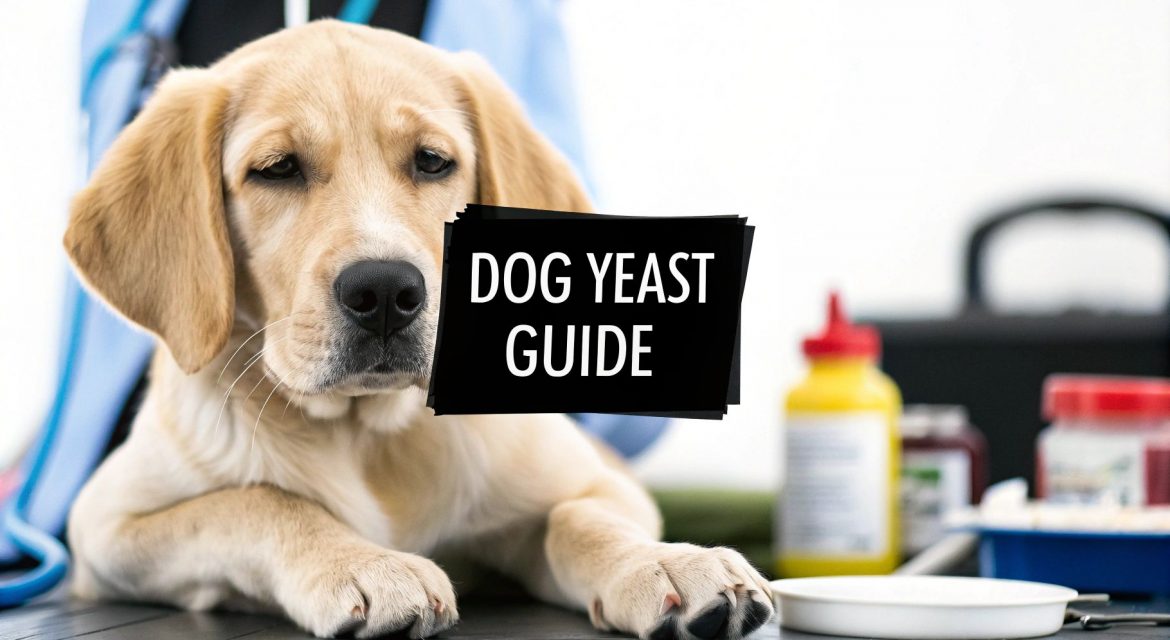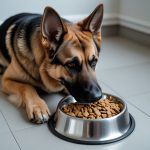It’s just awful watching your dog go through endless cycles of scratching, licking, and chewing. That constant discomfort isn’t just a quirky habit; it’s often a big red flag for a deeper issue, and a yeast infection is one of the most common culprits. If you’re feeling worried and powerless, you’re not alone, and we’re here to help you get to the bottom of it.
How to Spot a Yeast Infection in Your Dog
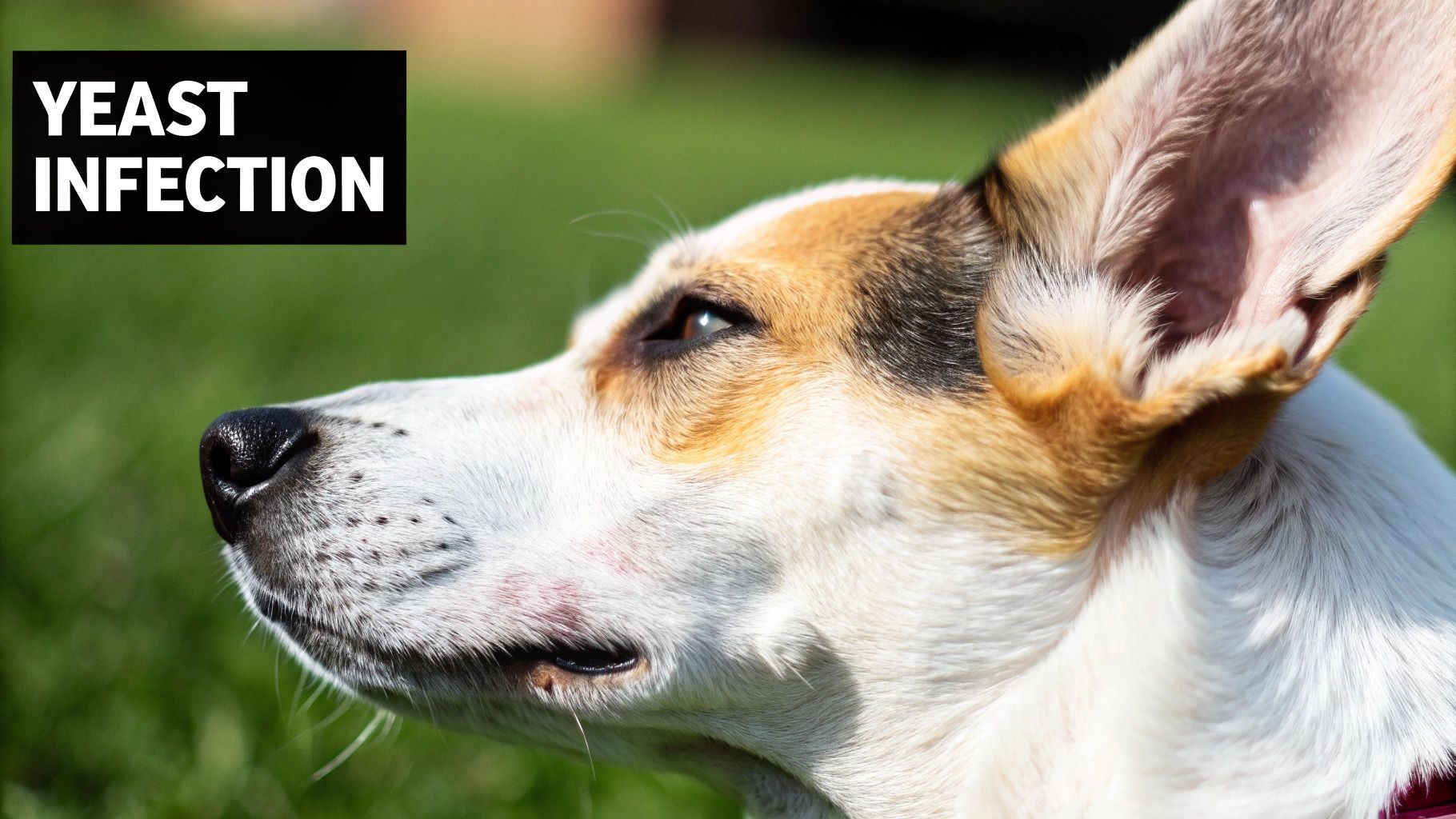
Figuring out if yeast is the problem can feel a bit like detective work. But once you know what to look for, the clues become much clearer. This isn’t just about ticking boxes on a checklist; it’s about us recognising the specific patterns of discomfort your companion is showing you.
Watching your best friend suffer from a relentless itch is tough. You might notice them frantically scratching their ears, gnawing at their paws, or even rubbing their body against the furniture just to get a moment’s relief. This isn’t your dog’s normal, everyday scratch—it’s a persistent, frustrating itch that offers them no peace.
The Unmistakable Smell
One of the biggest giveaways of a yeast infection is the smell. Many of us dog parents describe it as musty, cheesy, or even like corn chips. If you’ve ever caught a whiff of this odd odour coming from your dog’s ears or paws (a phenomenon often called ‘Frito feet’), you’re likely smelling the yeast itself.
This smell is a powerful signal that something is out of balance. The yeast fungus, Malassezia pachydermatis, is a normal resident on your dog’s skin. But when conditions are just right for it to multiply, it grows out of control, causing that distinct odour and intense irritation.
“Think of a yeast infection like a garden where weeds suddenly take over. It’s not a failure in your care, but an indicator of an internal imbalance that has created the perfect conditions for them to thrive.”
Visible Changes to the Skin and Coat
Beyond the itching and the smell, you’ll often see physical changes, too. The affected skin can become red, inflamed, and feel greasy or oily to the touch. In chronic cases that have been going on for a while, you might notice the skin thickening and turning a dark grey or black colour, a condition known as hyperpigmentation.
You may also see:
- Scaly or Flaky Skin: Similar to dandruff, you might find flakes of skin in their fur or on their bedding.
- Hair Loss: All that constant scratching and licking can lead to bald patches, especially around the ears, paws, and underbelly.
- Moist Sores: In more severe cases, the skin can become so irritated that open sores or moist, weeping areas develop.
These infections are surprisingly common in the UK. In fact, research highlights that Malassezia pachydermatis is a frequent cause of yeast dermatitis in dogs across the country. This yeast loves warm, moist areas, making skin folds and mucous membranes prime real estate. It’s no surprise that ear infections (otitis externa), which are heavily linked to yeast, affect around 10% of dogs visiting primary care vet practices. You can learn more from these findings on canine skin health from the National Center for Biotechnology Information.
The signs can pop up anywhere, but they often cluster in specific hotspots. Paying close attention to these areas can help you and your vet pinpoint the problem much faster.
Quick Symptom Checker for Canine Yeast Infections
To help you put the pieces together, here’s a quick summary of what to look for, smell, and observe in your dog’s behaviour.
| Symptom Category | What to Look For |
|---|---|
| What You See | Redness and inflammation, greasy or oily skin, hair loss or bald patches, scaly or flaky skin (like dandruff), dark, thickened skin (hyperpigmentation), and sometimes moist sores or a waxy, dark discharge in the ears. |
| What You Smell | A musty, cheesy, or sweet odour often compared to stale popcorn or corn chips. This smell is most noticeable from the ears, paws, and any affected skin folds. |
| What You Notice | Constant scratching, licking, or chewing at the skin, paws, or ears. Your dog might also shake their head frequently, rub their face on furniture or carpet, or seem generally restless and uncomfortable. They may also show signs of pain when touched in affected areas. |
This table is a great starting point, but we always have to remember that a proper diagnosis must come from your vet.
Recognising these symptoms is the first, most crucial step toward getting your companion the relief they so desperately need. By understanding what to look for, you’re in a much better position to have a productive conversation with your vet and get started on the right path to healing.
Understanding The Root Causes Of Yeast Infections
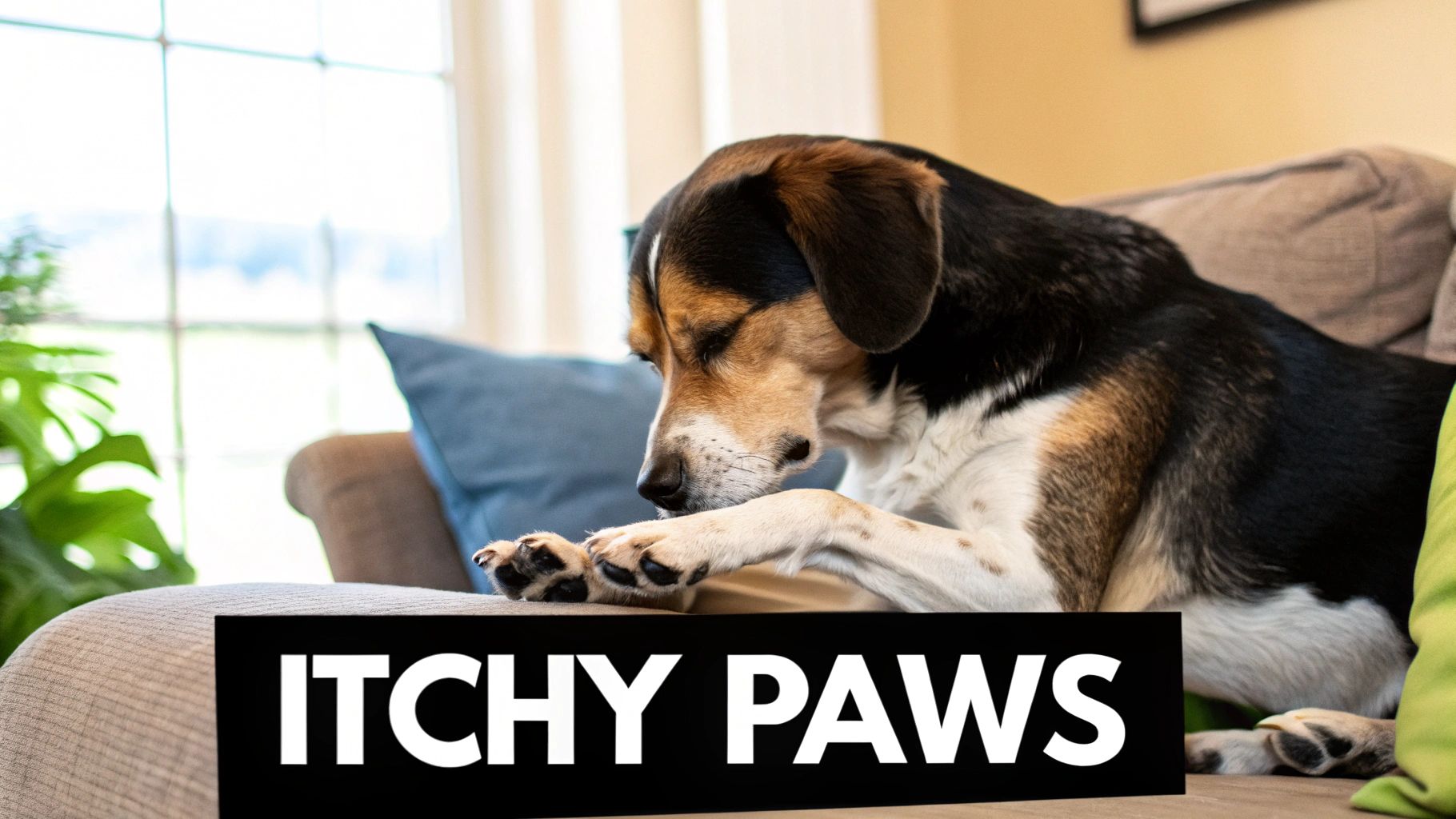
If you’re reading this, you might be feeling a little guilty, wondering what you could have done differently. Let’s get one thing straight right away: a yeast infection in dogs is almost never your fault. It’s not a sign of poor care but an indicator of an internal imbalance, and it’s something we can tackle together.
Think of your dog’s skin as a garden. Normally, it’s a balanced ecosystem with all sorts of helpful organisms living together peacefully. Yeast is one of those normal residents, but when the conditions change, it can act like a weed, growing out of control and causing all sorts of problems.
Our goal here is to help you understand what might be fertilising those weeds, so you and your vet can get your dog’s garden back in balance.
The Allergy Connection
One of the most common culprits behind recurrent yeast infections is allergies. Whether it’s a reaction to something in their food (like chicken or certain grains) or something in their environment (like pollen, dust mites, or mould), allergies kickstart an inflammatory response.
This inflammation compromises the skin’s natural barrier, making it weaker and more susceptible to invaders. It also creates a warmer, moister environment—the perfect breeding ground for yeast. So, while you’re seeing a skin problem, the real trigger might be your dog’s immune system overreacting.
How Medications Can Disrupt The Balance
Have you ever been told to eat yoghurt after taking antibiotics? It’s because antibiotics, while crucial for fighting bad bacteria, can also wipe out the good bacteria that help keep everything in check. The same thing happens with our dogs.
A course of antibiotics can disrupt the delicate balance of microorganisms on your dog’s skin and in their gut, creating an opportunity for opportunistic yeast to multiply without its usual competition. Steroids, often prescribed for allergies, can also suppress the immune system, making it harder for your dog’s body to control yeast populations naturally.
A yeast overgrowth is a secondary problem. It’s a symptom that points to a deeper, primary issue. Identifying and managing that underlying cause is the only way to achieve long-term relief and prevent the frustrating cycle of recurrence.
This scientific study highlights the prevalence of skin fold dermatitis, a condition closely linked to yeast issues, particularly in certain breeds.
The data clearly shows that breeds with lots of skin folds, like the English Bulldog, have a significantly higher rate of dermatitis, creating an ideal environment for yeast.
Other Underlying Health Conditions
Sometimes, the root cause is an underlying medical condition that weakens the immune system or alters the body’s chemistry. These issues make it much harder for your dog to maintain a healthy skin environment.
Common underlying problems include:
- Hormonal Imbalances: Conditions like hypothyroidism (an underactive thyroid) or Cushing’s disease can directly impact skin health and immune function.
- Immune System Deficiencies: Some dogs may have a weakened immune system from birth or due to other illnesses, making them more prone to infections.
- Anatomy and Genetics: As we’ve seen, dogs with lots of skin folds or floppy ears that trap moisture are naturally more at risk.
Understanding these triggers is the first step toward effective management. By working with your vet to pinpoint the primary cause, you can create a targeted plan that not only treats the current flare-up but also helps prevent future ones.
For a broader overview of canine wellbeing, you might find our guides on dog health and care particularly helpful. Shifting your focus from blame to understanding is the most powerful tool you have.
Which Dogs Are More Prone to Yeast Issues?
Have you ever wondered if your dog’s specific breed or those adorable floppy ears might make them more prone to certain health problems? When it comes to yeast infections in dogs, you’re right to be curious. It’s not just bad luck; some dogs are genuinely more likely to suffer from these frustrating flare-ups because of their genetics, body shape, and overall health.
Let’s unpack this together. Understanding why your dog might be at a higher risk isn’t about worrying or assigning blame. It’s about empowering you with the knowledge to be proactive and stay one step ahead.
A Perfect Storm: Breed and Anatomy
Some of our most beloved breeds have physical traits that, while undeniably charming, create the perfect warm, damp, and dark environment where yeast loves to party. It’s like unknowingly rolling out the welcome mat for an unwanted guest who refuses to leave.
Here are the key anatomical culprits:
- Floppy Ears: Breeds like Basset Hounds, Cocker Spaniels, and Golden Retrievers have long, heavy ears that seal off the ear canal. This design traps moisture and heat while restricting airflow, essentially creating a tiny incubator for yeast overgrowth.
- Skin Folds and Wrinkles: Those endearing wrinkles on Bulldogs, Pugs, and Shar-Peis are notorious for trapping sweat, dirt, and debris. The constant skin-on-skin contact in these folds provides a prime breeding ground for a yeast infection to take hold.
- Hairy Inner Ears: Poodles and Schnauzers often grow a lot of hair deep inside their ear canals. This hair can easily block air circulation and trap earwax and moisture, leading to chronic ear problems.
These physical traits are a massive factor. In fact, research into canine skin conditions backs this up with hard evidence. One UK study of over 900,000 dogs found that skin fold dermatitis—a condition closely linked to yeast infections—was almost four times higher in wrinkly, flat-faced (brachycephalic) breeds like English Bulldogs compared to dogs with longer snouts.
Underlying Health Conditions
While breed and anatomy play a big role, a dog’s general health is an even more critical piece of the puzzle. A yeast infection is very often a secondary problem—a symptom of a deeper imbalance somewhere in your dog’s body.
The main triggers that can kick off a yeast overgrowth are shown below.
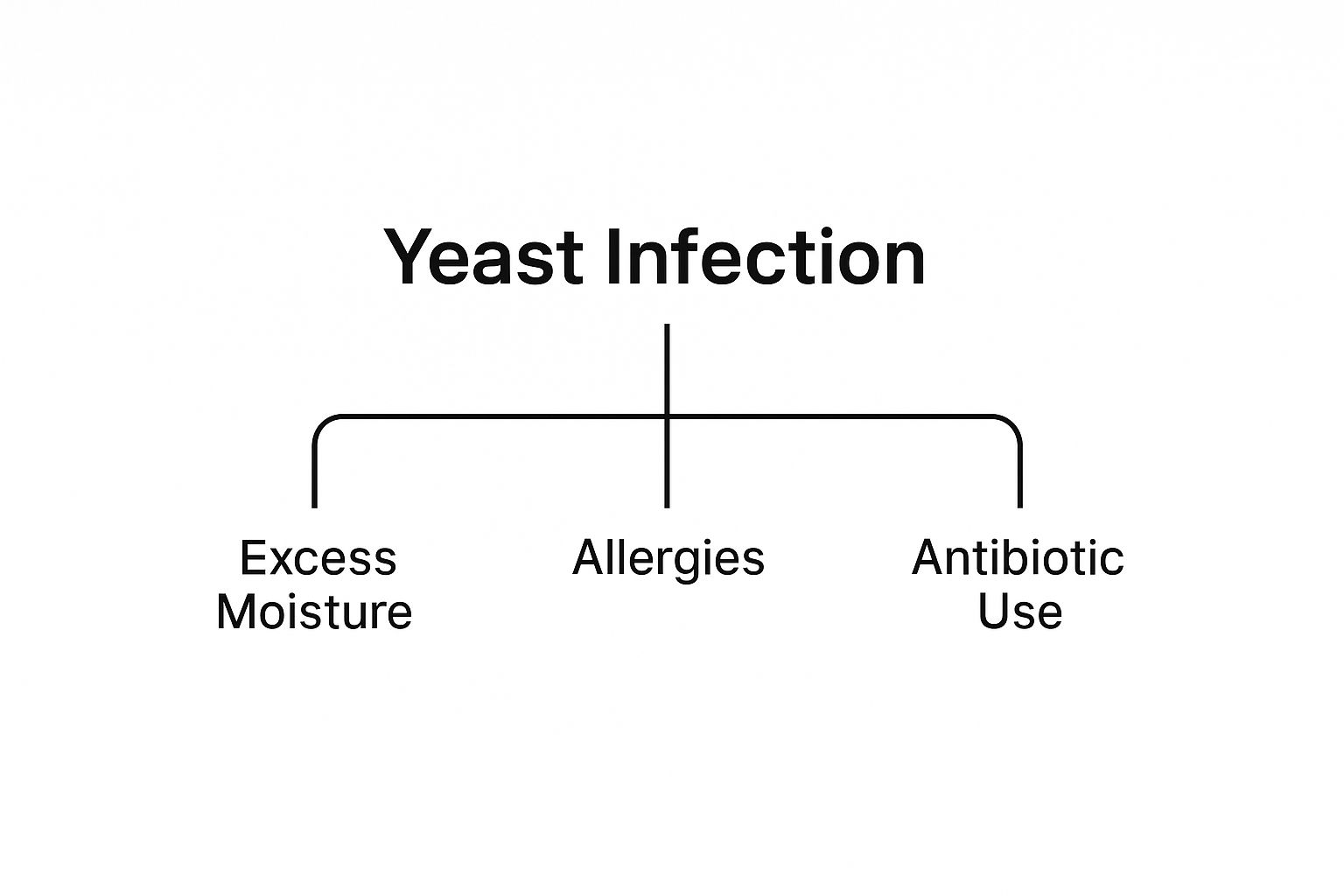
As you can see, things like excess moisture, allergies, and even a course of antibiotics can disrupt the skin’s natural defences, allowing yeast to multiply unchecked. A weakened immune system is a major predisposing factor.
It’s so important to think of a yeast infection not as the core issue, but as a bright, flashing warning light. It’s signalling that something else is going on under the surface that needs your attention.
The table below breaks down the most common risk factors that can tip the scales in favour of yeast.
Common Risk Factors for Yeast Infections in Dogs
| Factor Type | Specific Examples | Why It Increases Risk |
|---|---|---|
| Breed & Anatomy | Floppy ears (Basset Hound), skin folds (Bulldog), hairy ear canals (Poodle) | These traits trap heat, moisture, and debris, creating a dark, damp environment where yeast thrives. |
| Underlying Allergies | Food allergies (e.g., to chicken, beef), environmental allergies (e.g., to pollen, dust mites) | Allergic reactions cause skin inflammation, weakening its natural barrier and making it more susceptible to infection. |
| Immune & Hormonal Issues | Hypothyroidism, Cushing’s disease, autoimmune conditions, recent steroid use | These conditions compromise the immune system, reducing the body’s ability to keep the natural yeast population in check. |
| Medication & Diet | Recent antibiotic courses, high-sugar or high-carbohydrate diets | Antibiotics can kill off beneficial bacteria that compete with yeast. Sugars and carbs can feed the yeast, promoting overgrowth. |
Ultimately, any health condition that weakens your dog’s immune system makes it much harder for their body to keep yeast populations under control. This is especially true as dogs get older, since many of the underlying issues that fuel yeast infections become more common in their senior years. Getting familiar with the range of common senior dogs’ health issues can help you spot potential problems early.
By recognising these risk factors—from their adorable wrinkly face to a new allergy—you and your vet are far better equipped to build a solid management plan. A good plan won’t just treat the current infection; it will help you get to the root cause to prevent the next one.
How Vets Diagnose and Treat Yeast Infections
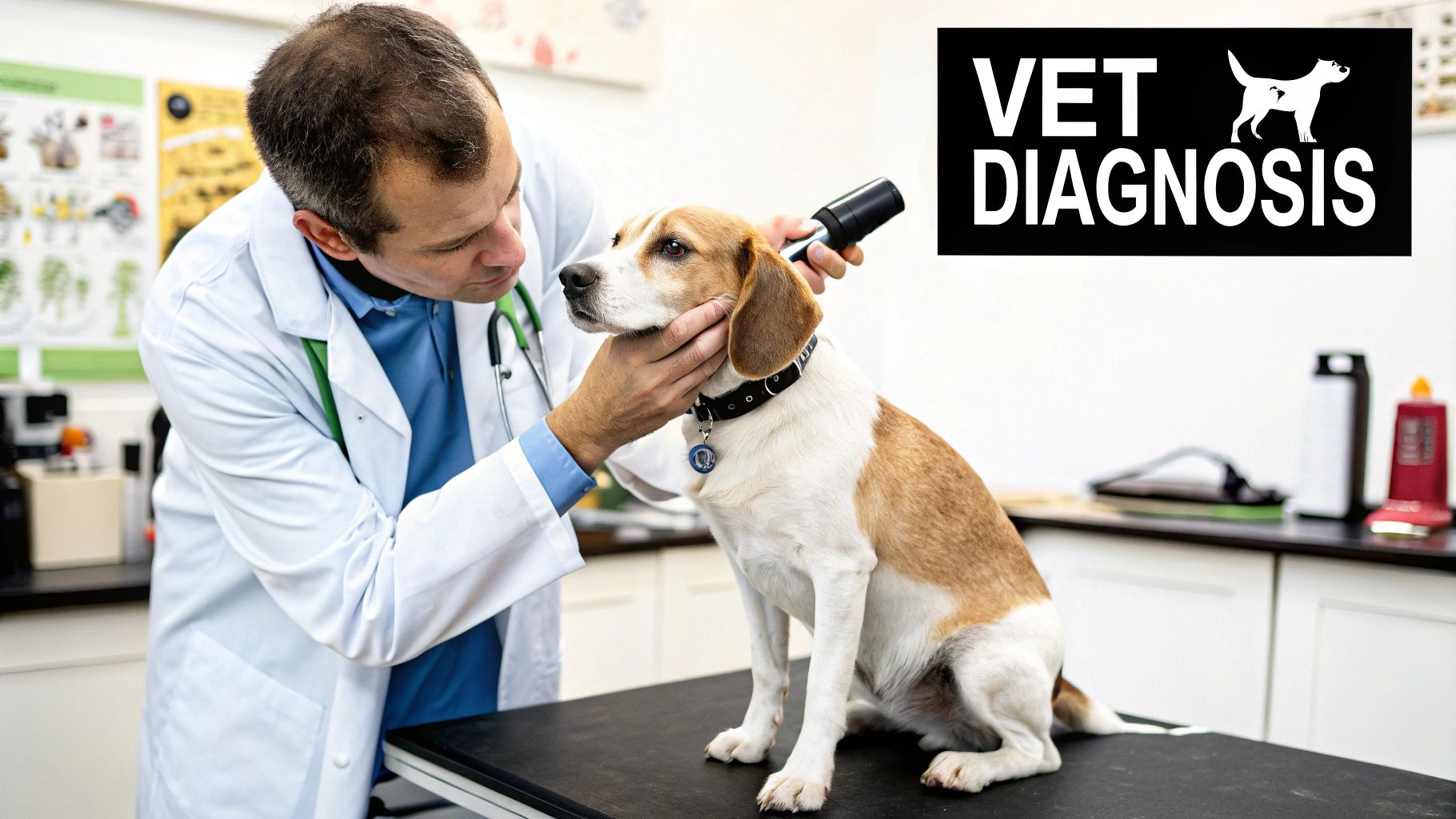
There’s nothing quite like the stress of walking into the vet’s surgery with a clearly uncomfortable dog. You’re worried, they’re miserable, and the not-knowing can be the worst part. We get it. Knowing what to expect during the visit can make a world of difference, helping you stay calm and be the best advocate for your furry friend.
The good news? Pinpointing a yeast infection in dogs is usually a very straightforward process. Your vet will combine a good old-fashioned physical exam with a few simple, painless tests to get to the bottom of all that itching and scratching.
Let’s walk through the steps together, so you feel totally prepared.
The Diagnostic Journey Uncovered
First things first, your vet will perform a thorough physical examination. They’ll have a close look at all the sore spots—whether it’s the ears, paws, skin folds, or belly—checking for those classic signs like redness, a greasy feel, and that tell-tale musty odour. They’ll also ask you plenty of questions about your dog’s history, symptoms, and any recent changes to their routine.
But to be absolutely sure it’s yeast they’re dealing with, your vet needs to find the little culprits themselves. Don’t worry, this isn’t as complex or scary as it sounds! They’ll most likely use one of these gentle techniques:
- Skin Cytology (Tape Prep): This is one of the most common and clever tricks of the trade. Your vet simply presses a piece of clear sticky tape onto the affected skin. This lifts off a perfect sample of surface cells, yeast, and bacteria. The tape is then stained and popped under a microscope, where the little peanut-shaped Malassezia organisms are easy to spot if they’re having a party.
- Skin Scrape: For this, the vet uses a scalpel blade to gently scrape the skin’s surface. It sounds a bit intimidating, but it’s typically painless and just collects a sample of skin cells and debris for the microscope. It’s also a great way to rule out other pesky problems, like skin mites.
- Cotton Swab Sample: If the ears are the epicentre of the problem, your vet will use a cotton swab to gently collect a sample of the waxy discharge. Just like the tape prep, this sample gets smeared onto a glass slide, stained, and checked for an overgrowth of yeast and bacteria.
These quick tests give your vet a crystal-clear picture of what’s happening on your dog’s skin, confirming if yeast is the issue and pointing them towards the best treatment.
Crafting The Right Treatment Plan
Once a yeast infection is confirmed, treatment is a two-pronged attack: first, we get rid of the current overgrowth, and second, we tackle the underlying reason it happened in the first place. Your vet will create a plan tailored specifically for your dog, which usually involves a mix of topical treatments and sometimes oral medication.
The absolute cornerstone of treating a yeast infection in dogs is topical therapy. This just means applying medication directly to the skin.
- Medicated Shampoos: Your vet will probably prescribe a shampoo with an antifungal ingredient like miconazole or ketoconazole. Bathing your dog with this shampoo, often 2-3 times per week to start, is brilliant for cutting through the greasy build-up, killing the yeast, and soothing the inflamed skin.
- Wipes, Sprays, and Creams: For smaller, localised flare-ups—like between the toes or in deep skin folds—medicated wipes or creams are perfect. They let you treat a specific area without the hassle of a full-body bath every day.
It’s so important to follow your vet’s instructions to the letter and finish the entire course of treatment. If you stop early just because your dog seems better, the infection can bounce right back, trapping you in a frustrating cycle of flare-ups.
For more severe, widespread, or stubborn infections, topicals alone might not cut it. In these cases, your vet may prescribe oral antifungal tablets or liquids, such as ketoconazole, itraconazole, or fluconazole. These work from the inside out to bring the yeast population back to a normal, healthy level.
It’s also crucial to remember that other health problems can invite yeast to take over. For example, UK research has shown a fascinating link between diabetes and yeast. The study found that a whopping 36% of diabetic dogs had Candida yeast in their digestive systems, compared to none in the healthy group. This suggests poor metabolic control can fuel yeast growth. You can dive into the full study on the National Center for Biotechnology Information website.
This is exactly why identifying and managing any underlying health issue isn’t just an add-on; it’s an essential part of the treatment plan to stop the problem from coming back.
Home Care and Prevention That Actually Works
Getting a diagnosis and a treatment plan from your vet is a massive step forward. It brings such a sense of relief. But your job doesn’t stop when you walk out of the clinic door. In fact, what you do at home is probably the single most important part of getting your dog better—and keeping them that way.
We know it can all feel a bit overwhelming, but think of this as your practical playbook for success. You and your vet are a team. They bring the medical expertise; you bring the daily care that turns that expertise into real, lasting results. Let’s break down exactly what you can do at home to support your dog’s recovery and stop future yeast flare-ups in their tracks.
Mastering Medicated Baths
Medicated bathing is usually the cornerstone of treatment, but it’s a world away from a quick scrub in the tub. To get it right, you need to think of bath time as a targeted treatment session.
That special shampoo from your vet isn’t just for cleaning. It’s packed with powerful antifungal ingredients that need time to do their job. Always follow the instructions on the bottle, but you’ll generally need to let the lather sit on your dog’s skin for a good 10-15 minutes before rinsing. This contact time is absolutely essential for the medication to kill off the yeast.
Drying is just as crucial as washing. Yeast loves moisture, so after the bath, be meticulous. Towel-dry your dog thoroughly, paying extra attention to those notorious damp spots like skin folds, armpits, and between their toes. A hairdryer on a low, cool setting can be brilliant for making sure every last nook and cranny is bone dry.
The image below, from a clinical study, shows just how effective these antifungal treatments are at reducing yeast colonies on the skin.
This is what you’re aiming for. The medicated baths you’ll be doing at home directly combat the yeast overgrowth, just like in this study.
Maintaining Those Tricky Areas
Beyond the full-body baths, daily spot-cleaning is your secret weapon. This is especially true for breeds with lots of skin wrinkles or those adorable floppy ears—these are prime real estate for yeast.
- Skin Folds: Gently wipe inside every skin fold, every single day. Use a medicated wipe or a soft cloth dampened with a solution your vet has approved. This clears out the sweat, grime, and moisture that yeast thrives on.
- Paws: Your dog’s paws are constantly in contact with potential allergens and moisture from the ground. Wiping them down after every walk, particularly on damp days, is a simple habit that makes a huge difference.
- Ears: If your vet has given you an ear cleaner, use it exactly as they’ve shown you. Regular cleaning removes the waxy build-up that creates a welcoming environment for yeast.
Proactive Prevention for Long-Term Health
Once you’ve got the current infection under control, your focus needs to shift to prevention. The goal is to make your dog’s body an unfriendly place for yeast to get out of hand again.
A big part of this strategy is managing parasites. Fleas are more than just an itchy nuisance; their bites can trigger allergic reactions that damage the skin’s natural barrier, rolling out the welcome mat for secondary infections like yeast. You can find our expert advice on effective dog fleas control to keep them well away from your pet and your home.
Remember, prevention isn’t a one-time fix. It’s an ongoing commitment. A consistent routine of grooming, proper diet, and a clean environment is the most powerful tool you have to break the frustrating cycle of a recurring yeast infection in dogs.
Here are some long-term strategies to consider:
- Diet and Nutrition: Have a chat with your vet about your dog’s food. If a food allergy is a possible culprit, they might suggest a prescription or elimination diet. Some evidence also suggests that diets lower in carbohydrates can help, as yeast feeds on sugar.
- Supplements: Your vet may recommend supplements to bolster your dog’s skin health. Omega-3 fatty acids are fantastic for reducing inflammation, while probiotics can help maintain a healthy balance of microbes in the gut and on the skin.
- Consistent Grooming: Regular brushing and grooming do more than just keep your dog looking sharp. It gives you a chance to check their skin for any early warning signs, removes loose hair and dander, and helps air circulate, keeping the skin healthier.
By combining your vet’s medical plan with these dedicated home care and prevention tactics, you really can take control. You can break the cycle of infection and help your best friend live a much more comfortable, itch-free life.
Your Top Questions About Dog Yeast Infections, Answered
When you’re staring at your best friend’s red, itchy skin, it’s only natural for a hundred questions to start racing through your mind. The worry can feel overwhelming, and sometimes, you just need straight answers to cut through the noise.
We get it. That’s why we’ve put together a few of the most common questions we hear from pet parents just like you. Think of this as a chat with a trusted friend who happens to have the vet-reviewed info you’re looking for. Our goal is to bring you some clarity and peace of mind.
Is a Dog Yeast Infection Contagious to Other Pets or Humans?
This is usually the first thing on every owner’s mind, and thankfully, the answer is reassuring. No, a yeast infection in dogs isn’t considered contagious to other pets or the people in your home.
The fungus responsible, Malassezia, is a totally normal resident on the skin of most healthy dogs (and us, for that matter!). The problem isn’t that the yeast is there; it’s that it’s having a party. An infection only kicks off when an underlying issue—like allergies or a compromised immune system—throws the skin’s natural balance out of whack, letting the yeast multiply like crazy.
So, a healthy pet or person with a normal skin environment isn’t at risk of “catching” it from your poorly pup. The real mission is always to figure out what’s triggering the overgrowth in your individual dog.
Can I Use Over-the-Counter Human Treatments on My Dog?
Seeing your dog in misery makes it incredibly tempting to grab that antifungal cream from your own medicine cabinet. We understand the urge to bring them instant relief, but please, fight that temptation.
You should never use human over-the-counter medications on your dog without getting the green light from your vet first. This is a big one, and here’s why:
- Potential for Poisoning: Many products made for us contain ingredients that are perfectly safe for humans but can be toxic if your dog licks them off and ingests them.
- Wrong Strength: The active ingredients in human formulas are balanced for human skin. They could be far too harsh for your dog, causing even more irritation or painful chemical burns.
- Hiding the Real Issue: Most importantly, a human cream might dull the symptoms for a bit, but it does nothing for the root cause. This can delay a proper diagnosis and the right treatment plan from your vet.
It’s always safest to stick to products specifically prescribed or recommended for your dog. It’s the only way to be sure they’re getting safe, effective care.
A vet’s treatment plan is a targeted prescription, chosen just for your dog. Using a human product is like trying on someone else’s glasses—it might seem to help for a second, but it won’t fix the real problem and will probably just give you a headache.
How Long Does It Take to Clear Up a Yeast Infection?
“How long is this going to take?” It’s a question that comes straight from the heart, from wanting to see your companion happy and comfortable again. Unfortunately, there’s no single answer, as the recovery time really hinges on a few key things.
The two biggest factors are the severity of the infection and how quickly the underlying trigger can be sorted out.
- Mild, Localised Flare-ups: If you’ve caught a minor infection early on—say, just between the toes—you could see a huge improvement within 1-2 weeks of starting topical treatments like medicated wipes or shampoos.
- Severe or Chronic Cases: For more widespread or stubborn infections that need oral antifungal meds, the journey is longer. It can often take several weeks to a month or more to completely get things under control and let the skin fully heal.
The absolute key to a speedy recovery is consistency. Following your vet’s plan to the letter—without skipping medicated baths or doses of medicine—is your best bet for knocking out the infection for good.
Can Changing My Dog’s Food Cure a Yeast Infection?
Diet is a massive topic for dog owners, and for good reason—it’s the foundation of good health. So, it makes sense to wonder if a food switch could be the magic wand for a yeast infection.
While diet can be an essential part of the management plan, it very rarely cures an active infection all by itself. Think of it as a powerful support tool, not a standalone fix.
However, if a food allergy is what’s causing the skin inflammation in the first place, then changing your dog’s diet is absolutely crucial for preventing the yeast from coming back. Your vet might suggest:
- A hypoallergenic or prescription diet with special hydrolysed proteins that the immune system doesn’t recognise as a threat.
- A novel protein diet, which uses a protein source your dog has never had before, like rabbit or venison.
- A lower-carbohydrate diet, as some believe that sugars and simple carbs can “feed” yeast. This is usually secondary to tackling any allergies, though.
The best way to think about it is this: diet is a long-term strategy for building a healthier foundation for your dog’s skin. It works alongside the medical treatments needed to clear the current flare-up.
At My Life My Dog, we believe that informed owners are empowered owners. Having the right knowledge helps you partner with your vet to give your dog the best possible care. For more in-depth guides on everything from health to nutrition, visit us at https://mylifemydog.com.


